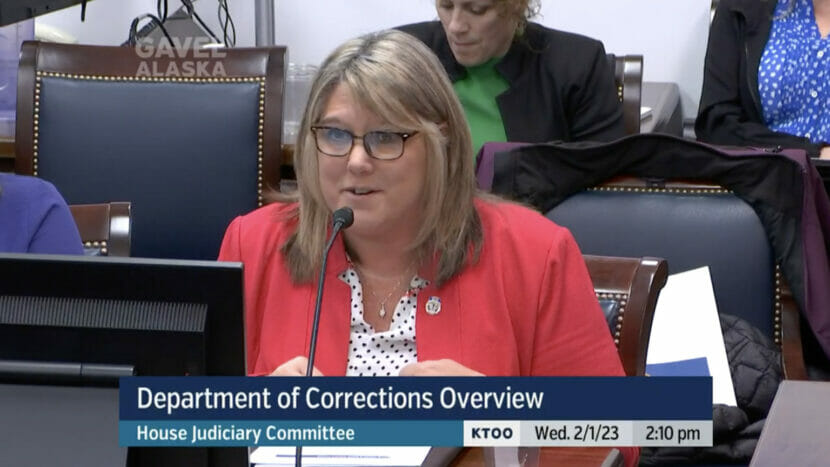
Alaska’s Department of Corrections commissioner told legislators Wednesday that the 18 in-custody deaths in 2022 – seven of which were a result of suicide – were high.
“That is too many. I absolutely know that,” Jen Winkelman said while giving an overview of the department to the House Judiciary Committee. “They are somebody’s brother, they are somebody’s sister, they are somebody’s family member.”
Corrections ended 2022 with a decade-high number of deaths. All but one of the 18 deaths took place while Winkelman was leading the department. During a news conference last October, she said the deaths were not unusual. At the time, 15 people had died in Corrections custody.
“While it’s unfortunate to have any death, it is not unusual and it is not a reflection on our staff’s ability to care,” she had said then. She also called those in Corrections custody “a very sick population.”
Though acknowledging 18 deaths was “too many,” Winkelman on Wednesday reiterated that the population is “unhealthy.”
“Stats have shown that over 50% have some sort of a chronic medical condition beyond a common cold or COVID or something like that, so they come to us beyond that point of prevention,” she said.
According to the Corrections website, which Winkelman said was updated last week, of the 18 in-custody deaths in 2022, seven were a result of suicide and 11 were “natural.” Causes for natural death “include cancer, coronary, gastro-intestinal, chronic ethanol abuse, end-stage liver and renal disease, cardiovascular/pulmonary disease, hemorrhage, respiratory issues, infectious diseases, etc.” The category also includes deaths listed as “undetermined” by the State Medical Examiner’s Office, the website says. Other categories include accident or homicide; no deaths from 2022 fall in either.
Displaying the cause of in-custody deaths is new to the website. It’s part of the department’s effort of “getting information out to the general public,” Winkelman said.
Previously, the department would not answer the Beacon’s request for cause of in-custody deaths – specifically if a death was due to apparent suicide – and instead deferred to the Department of Health’s State Medical Examiner’s Office, which determines the cause of in-custody deaths. The Department of Health also did not release the information, citing privacy laws.
Of the 18 deaths in 2022, eight were sentenced and 10 were unsentenced, Winkelman told the committee. She also said 50% of the 11 natural deaths were receiving end-of-life care.
Website information on in-custody deaths goes as far back as 2015, when 15 people died in Corrections custody – the previous decade-high number before 2022. That year, three deaths were a result of suicide, one from homicide and 11 natural, according to Corrections.
After 2022, the next highest number of deaths by suicide was five in 2020. The rest of the 14 total deaths that year were from natural causes.
To reduce the number of suicides in custody, Winkelman said Corrections is working with Project 2025, a nationwide initiative by the American Foundation for Suicide Prevention to reduce the annual rate of suicide in the U.S. 20% by 2025.
A division within Corrections is “working to develop and work with them and their resources. Are we assessing folks correctly and accurately when they come in?” Winkelman told the committee. “Are we auditing afterwards that we have done what we need to, to maybe not have that happen again?”
Winkelman said the commissioner’s office has recently hired for a new position to coordinate the various investigations that take place when someone dies in Corrections custody. And the department is reviewing its death of prisoner policies and procedures,
“We have a group that has been working on that, making sure that any updates that needed to be done, it was due for review. I believe that Law is reviewing it as we speak,” Winkelman said.
If you or someone you know is in emotional distress or considering self-harm or suicide, you can call or text 988 to access a trained crisis counselor.
This story originally appeared in the Alaska Beacon and is republished here with permission.